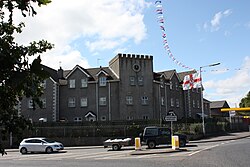Ballygowan
- Not to be confused with Ballygowan, County Antrim
| Ballygowan | |
| County Down | |
|---|---|
 Church Hill, Ballygowan | |
| Location | |
| Grid reference: | J430638 |
| Location: | 54°30’10"N, 5°47’33"W |
| Data | |
| Population: | 2,957 (2011) |
| Post town: | Newtownards |
| Postcode: | BT23 |
| Dialling code: | 028 |
| Local Government | |
| Council: | Ards and North Down |
| Parliamentary constituency: |
Strangford |
| Website: | http://www.ballygowan.info |
Ballygowan is a village and townland in County Down. The town of Comber is a short distance to the north-east, the town of Saintfield to the south, and the city of Belfast a further distance to the north-west.
Ballygowan is a busy commuter bypass and is said to border the 'Greater Belfast City District' providing excellent travelling distance to Belfast City Centre. It is said to one of the most wealthy places of County Down (based on household income), similar to that of North Down.
The townland of the same name is part of the Castlereagh Lower Baront of Downshire.[1]
The townland had a population of 2,957 people in the 2011 Census.
History
Before the Plantation of Ulster in the reign of King James I, the area surrounding Ballygowan was sparsely inhabited by subsepts of the great 'Neill clan of Castlereagh.
In King James’s days, in the early 17th century, many families moved over from the Lowlands of Scotland to settle in northern Down on lands granted by the King to James Hamilton (later 1st Viscount Claneboye) and Hugh Montgomery (later 1st Viscount Montgomery), Since the late 17th century the population has been predominantly Presbyterian.
In the late 18th century the village comprised a bridge (over the River Blackwater at the intersection of the Comber/Saintfield and Killyleagh/Belfast roads), a dozen or so small houses and an inn. The surrounding townlands were populated by a great number of small tenant farmers and weavers. The main landlords were Lord Dufferin and Lord Londonderry.
From the mid-19th century through the early 20th century the population of the rural area surrounding Ballygowan declined considerably as many people emigrated to North America or found work in Comber, Saintfield and particularly in Belfast. However, it was during this period, and subsequent to the introduction of the Belfast & County Down Railway in 1850, that the village began to grow. Ballygowan railway station opened on 10 September 1858, but finally closed on 16 January 1950.[2] After the railway closed in 1950 the village became an attractive "dormitory" town and the ensuing 50 years have seen rapid growth.
On Monday, 15 September 2014, the body of Lord Bannside (better known as The Rev. Ian Paisley) were buried in the graveyard attached to Ballygowan Free Presbyterian Church.
Railways
The Ballygowan railway station was opened by the Belfast and County Down Railway on 10 September 1858.[3] The station was on the once extensive network that connected Belfast Queen's Quay railway station to Downpatrick and Newcastle.
The station was closed in 1950 by the Ulster Transport Authority.
Outside links
| ("Wikimedia Commons" has material about Ballygowan) |
References
- ↑ "Ballygowan". Placenames database of Ireland. http://www.logainm.ie/Viewer.aspx?text=Ballygowan&streets=yes. Retrieved 21 February 2013.
- ↑ "Ballygowan station". Railscot - Irish Railways. Archived from the original on 26 September 2007. https://web.archive.org/web/20070926042407/http://www.railscot.co.uk/Ireland/Irish_railways.pdf. Retrieved 2007-09-11.
- ↑ "Ballygowan Halt station". Railscot - Irish Railways. http://www.railscot.co.uk/Ireland/Irish_railways.pdf. Retrieved 2012-05-06.
